Cloud computing is the foundation for many modern business applications, and companies are shifting from traditional data centers to flexible cloud solutions that support collaboration, scalability and better security. The community cloud is gaining popularity as a middle-ground cloud computing model that balances the strengths of public and private clouds.
A community cloud is designed for a specific community of users, such as multiple organizations that operate in the same industry or share compliance requirements. In this guide, we will explore what makes the community cloud unique by discussing its real-world applications, benefits and challenges while comparing it to other cloud models.
A community cloud is a shared cloud environment where multiple organizations with similar needs collaborate using common infrastructure.
Unlike public clouds that serve broad audiences or private clouds that are dedicated to a single entity, the community cloud model is designed for specific communities, such as healthcare providers, financial institutions or government agencies.
Community clouds allow members to share resources, applications and data governance tools while maintaining control over sensitive data. They must meet strict compliance requirements and enable data sharing among trusted partners. For example, hospitals in a healthcare sector network can securely exchange patient data without violating privacy laws.
A cloud service provider manages the underlying infrastructure to ensure high availability and disaster recovery, while community members retain governance over their own data and applications.
This flexibility is ideal for industries that require strong collaboration and security. By pooling resources, members can reduce expenses and benefit from enterprise-grade security protocols.
Community cloud computing can take different forms depending on who owns it, who manages it, and what resources are shared among the participating organizations. By understanding these distinctions, an organization can choose the right community cloud model that aligns with its needs.
We will break down the community cloud into three main categories based on the infrastructure’s ownership, management and the types of shared resources involved.
Ownership refers to who owns the cloud infrastructure and resources used in a given community cloud model. The two main types include on-premises community clouds and third-party community clouds.
- On-premises community clouds: In this type, the cloud infrastructure is hosted in data centers owned by one or more of the participating organizations. The infrastructure resources are on site, and many organizations are responsible for governance, security protocols and compliance considerations. This approach offers greater control but requires significant technical expertise and collaborative planning among members.
- Third-party community clouds: An external cloud service provider owns and operates this type of community cloud environment. Organizations pay for access while the provider handles maintenance, security and upgrades.
The management-based categories focus on the party that is tasked with running and maintaining the cloud services. The two main types are self-managed community clouds and provider-managed community clouds.
- Self-managed community clouds: Community members manage this type of community cloud. They collaborate to handle tasks such as security testing, access control, compliance monitoring and disaster recovery. This gives organizations more direct control over resource usage and the protection of sensitive data. However, it also demands strong cooperation, clear governance frameworks and a well-defined change management process.
- Provider-managed community clouds: In this case, a cloud service provider manages the community cloud and oversees all the technical responsibilities, including virtualization technologies, continuous monitoring and regular security audits. This is best suited for communities with limited internal IT resources or small budgets, or those that want to focus on their core missions while a third party handles their infrastructure.
Community clouds may also differ based on the types of resources that are shared across the cloud platform. We will discuss two main types below: vertical community clouds and horizontal community clouds.
- Vertical community clouds: These are designed for organizations in the same industry. An example would be hospitals in the health sector that share patient data. The organizations involved often have shared compliance requirements, data types and security concerns.
- Horizontal community clouds: This type serves organizations from different industries that have similar IT needs, such as data storage, communication tools or development platforms. Though their regulatory requirements may differ, the participating members benefit from resource sharing, virtualization platforms and centralized cloud services. This model focuses on solving general-purpose challenges across multiple companies.
Community cloud architecture is built to support specific communities — typically, those with shared data security, regulatory compliance and infrastructure management needs. The architecture includes shared physical hardware with virtualization technologies that logically separate each tenant’s data and applications, ensuring that their operations remain isolated and secure.
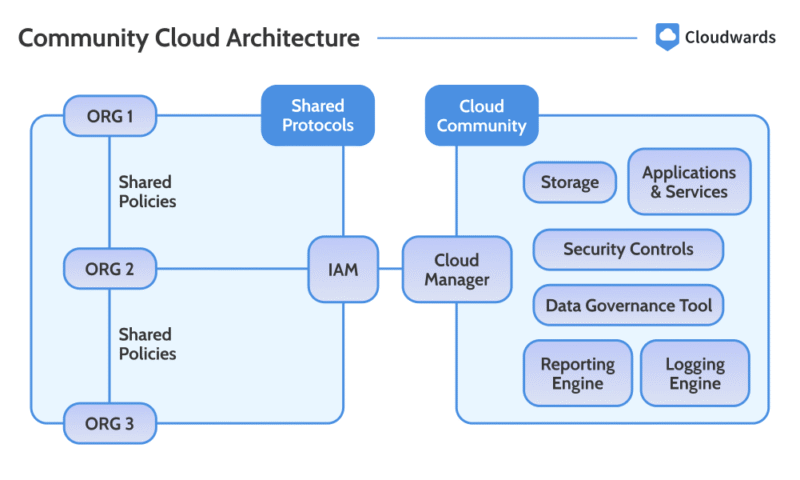
Multiple organizations can securely share resources through common
IAM protocols and centralized management.
A community cloud model includes a combination of data centers, network systems, virtualization platforms and service layers. These are either hosted on-premises or managed by a cloud service provider.
Each component is set up to ensure that the resources are available on demand, and they are securely partitioned through separate servers or virtual machines. The members will benefit from reduced costs in the shared environment while enjoying high performance and redundancy across multiple secure locations.
Security is deeply integrated into the community cloud architecture. Robust security measures — such as data encryption, firewalls, access management and security protocols — help protect against security breaches.
Many community clouds also implement continuous monitoring, compliance monitoring and regular security audits. This helps the participants align with organizational policies and external compliance requirements, such as HIPAA, GDPR or industry-specific regulations.
A well-structured community cloud architecture relies on more than just servers and software. It requires thoughtful planning, alignment among members, and tools that ensure security, compliance and collaboration. We will discuss some core elements that make the community cloud functional, secure and efficient across industries.
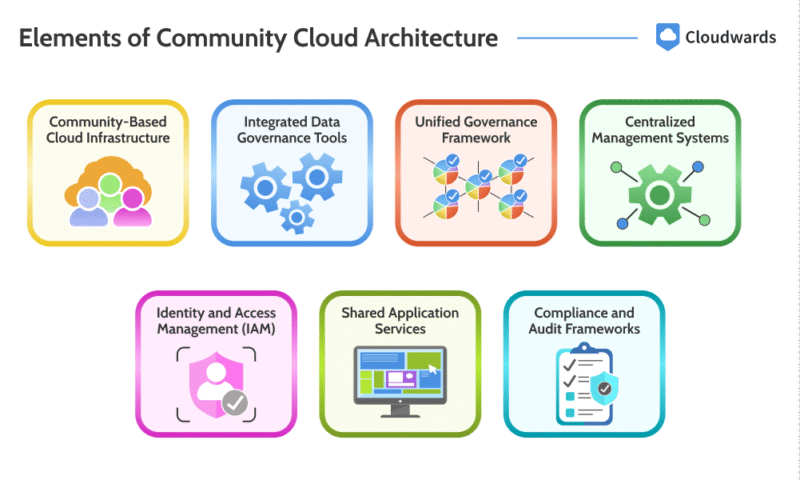
The community cloud architecture’s core components enable secure
collaboration, governance and regulatory compliance.
The shared infrastructure serves as the physical and virtual foundation of a community cloud. It may be hosted in on-premises data centers or managed by a third party. Although members operate within the same environment, their workloads are logically separated using virtual machines or separate servers, which allows for collaboration and strict data isolation.
Integrated Data Governance Tools
These specialized solutions help each organization in a community cloud manage its data effectively. In addition to providing granular control over data ownership and usage, they also track where data is stored, who accesses it and how it is shared — all while ensuring compliance with relevant regulations. Examples of such tools include Amazon Macie and Microsoft Purview.
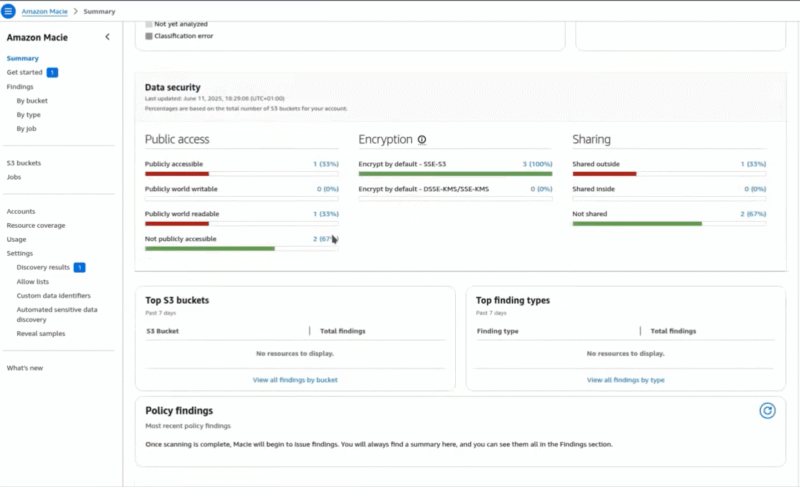
Amazon Macie enables organizations in a community cloud to discover, classify and protect sensitive data automatically, ensuring regulatory compliance and secure data sharing.
Unified Governance Framework
A unified governance framework serves as a rulebook for the community cloud, establishing standard policies that all members must follow. It defines operational rules, compliance checklists, data usage boundaries, and security and legal requirements related to data ownership and liability.
Strong governance frameworks ensure consistency across the community while providing flexibility for industry-specific needs.
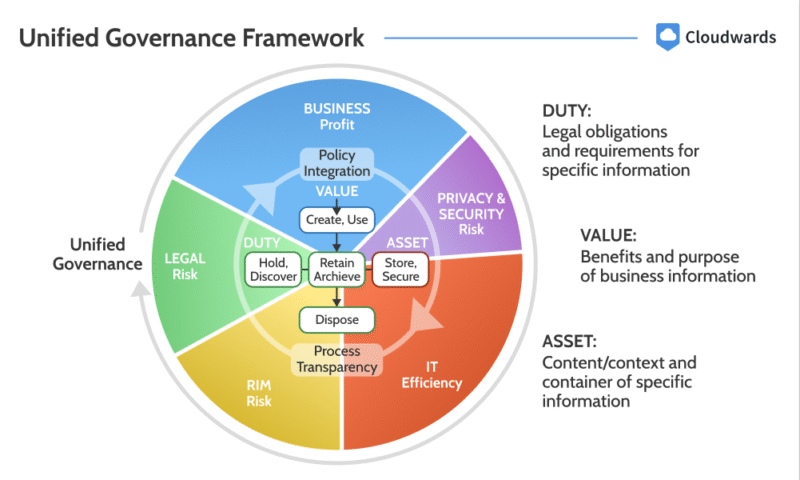
A unified governance framework acts as the community cloud’s rulebook,
ensuring that all members follow consistent policies.
Centralized Management Systems
Centralized management systems are tools and platforms that automate infrastructure management, performance monitoring and configuration across the cloud. A collaborative planning team oversees them to ensure consistency and facilitate a smooth change management process. These systems may be managed internally or via a cloud service provider.
Identity and Access Management (IAM)
IAM is a set of technologies and policies to ensure that only authorized users can access specific cloud resources. In community cloud computing, member organizations may have different roles, responsibilities and security clearance levels. Without proper access controls, unauthorized users could gain access to sensitive data across the same environment.
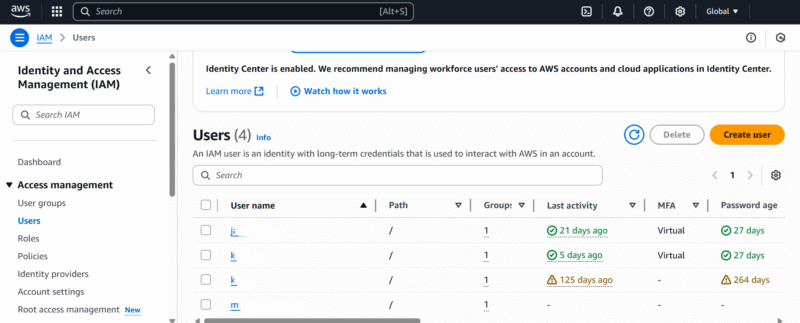
AWS IAM enforces role-based access controls, ensuring that only authorized users
from each organization can access sensitive community cloud resources.
Shared Application Services
All member organizations can use shared software and platform services, such as document sharing systems, customer relationship management (CRM) tools or healthcare-specific platforms for patient data.
By sharing these tools, members reduce duplication and ensure interoperability. The services must comply with security protocols, use secure connections and integrate with existing systems to encourage adoption.
Compliance and Audit Frameworks
Since community clouds serve regulated sectors, such as the government cloud or healthcare, a strong focus on regulatory compliance is necessary. This element includes tools and processes for regular security audits, security testing and reporting frameworks to ensure that each member complies with their sector’s legal obligations.
When deciding on a cloud deployment model, organizations often choose between public, private, hybrid and community clouds. Each model offers a different mix of control, cost, security and collaboration. Let’s explore how community cloud computing compares with the other major cloud types.
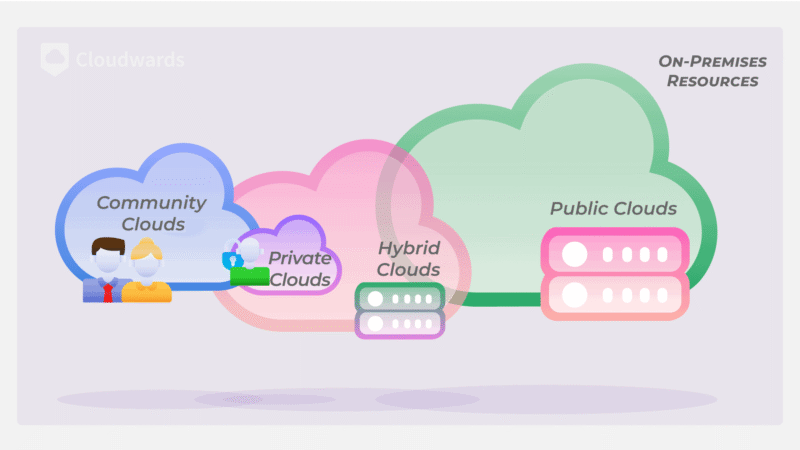
Different cloud types offer varying levels of control, security, cost and collaboration,
making them suitable for specific business and regulatory needs.
Community clouds are gaining popularity in industries where organizations must collaborate securely while meeting strict regulatory standards. Sharing infrastructure helps reduce costs, improve efficiency, enhance security and maintain compliance. We will discuss three main sectors where the community cloud has gained traction: the government, healthcare and finance.
Government Sector
In the government sector, community clouds are commonly used to connect different agencies or departments that must access common systems, public records and infrastructure while maintaining strict regulatory compliance.
Governments often have shared data ownership, disaster recovery and security requirements, which makes the community cloud a great fit.
An example would be the U.S. federal government’s FedRAMP-authorized community cloud. It allows agencies like the IRS, Social Security Administration and Department of Homeland Security to exchange taxpayer and immigration data while adhering to strict security protocols.
Healthcare Sector
Data sensitivity requirements and strict laws like HIPAA make cloud adoption challenging for the healthcare sector.
A community cloud provides a cost-effective way for hospitals, research centers and clinics to share access to patient data, medical applications and research data. It also ensures compliance, protects sensitive data through secure connections, and manages user access.
One real-world example is the U.K.’s NHS Health and Social Care Network (HSCN), which enables hospitals, general practitioner (GP) clinics and research institutions to share patient data securely.
Financial Sector
The financial sector operates under intense scrutiny due to strict regulatory compliance needs, such as PCI-DSS, GDPR and anti-money laundering protocols. A community cloud model helps financial institutions with similar compliance requirements operate within a shared infrastructure that supports mutual goals and keeps data secure.
An example is the Banking Industry Architecture Network (BIAN). It uses a community cloud model to help financial institutions share fraud patterns and anti-money laundering insights without exposing proprietary data.
Community cloud computing offers a unique blend of cost efficiency, security and collaboration, making it ideal for industries with shared regulatory and operational needs. It provides a tailored infrastructure where multiple organizations can work together while maintaining control over their data.
Below are some benefits of adopting a community cloud model.
- Cost-effective shared infrastructure: Community clouds reduce expenses by allowing multiple organizations to share the cost of infrastructure, maintenance and upgrades. Instead of each institution investing in its own expensive hardware and software systems, participants collectively fund and utilize a common platform.
- Enhanced security and compliance: Community clouds are built with enhanced security controls tailored to a specific community’s needs. With strict access management, data encryption and regular security audits, members can confidently store and process sensitive data. The model also comes with preconfigured compliance measures, including industry-specific regulations that simplify adherence to regulatory compliance requirements such as HIPAA and GDPR.
- Enhanced data sharing and collaboration: Community clouds promote data exchange between institutions with common interests. This cloud environment creates ideal conditions for secure collaboration among trusted partners. Operating in the same environment also ensures that tools and platforms work consistently across all users.
- Scalability and flexibility for growing needs: Community clouds support virtualization technologies that allow each organization to scale its workloads as needed. The infrastructure can also scale to accommodate new organizations or existing members that need more resources.
Organizations considering a community cloud environment must carefully evaluate whether the model fits their technical capabilities, governance needs and long-term goals. Many of the challenges stem from the nature of shared infrastructure, where multiple organizations must work together to manage resources, risks and policies.
Below are some of the disadvantages of operating within a community cloud infrastructure.
- Complex governance and collaboration issues: It can be challenging to establish and maintain a fair and effective governance model since the cloud is shared by multiple entities. Differences among organizations can complicate agreements and decision-making, so members will need to establish a proactive collaborative planning team to mitigate this challenge.
- Limited provider options and vendor lock-in: Community clouds require highly customized solutions that meet specific industry regulations and collaborative needs, which results in fewer qualified providers. This scarcity can lead to vendor lock-in, where organizations become dependent on a single provider.
- Shared risks and security concerns: A vulnerability in one part of the shared infrastructure can potentially affect other parts. If a member organization fails to follow best practices or delays applying critical updates, the whole community cloud could face increased security concerns.
Setting up or migrating to a community cloud is a strategic move that demands careful planning, coordination and alignment among multiple organizations. Success depends on how well the involved entities collaborate and manage the community cloud environment.

Following the best practices during setup helps ensure long-term success
and stability of the shared cloud environment.
Here are some considerations and best practices to ensure a smooth community cloud implementation.
Community cloud services typically cost more than standard public clouds but are cheaper than private cloud environments. The exact pricing varies depending on the scale, security requirements and number of participating members. Higher prices reflect the specialized infrastructure, compliance certifications and managed services required to support multi-tenant collaboration securely.
Certain setups may be pricier than others due to industry-specific compliance requirements, enhanced security demands, and hosting the environment via premium cloud service providers instead of a smaller regional provider.
Pricing is also affected if you require custom integrations with existing systems, high availability across multiple locations, and advanced virtualization technologies.
The community cloud model includes cost sharing among members, so multiple organizations split the expenses incurred while running the cloud. This makes community clouds more cost-effective than standalone private solutions.
A mix of specialized providers and major cloud platforms offer community cloud services that cater to industries requiring secure and compliant collaboration. Below are some of the most prominent providers in this space.
Final Thoughts
Community cloud computing offers powerful solutions in the cloud market, especially for industries with strict cost management, regulatory compliance and secure collaboration needs. By pooling resources, organizations avoid the high cost of building their own data centers while benefiting from a platform that is specialized to meet their needs.
Thank you for exploring this guide on community cloud computing with us. Has your organization considered adopting a community cloud model? How did you choose virtualization technologies for your current environment? Share your thoughts and experiences in the comments section below.
-
A public cloud is open to anyone and is managed by a cloud service provider. A community cloud is restricted to a specific group with common goals, and it often has stricter security requirements and compliance considerations.
-
The four main types of cloud computing are public cloud, private cloud, hybrid cloud and community cloud.









